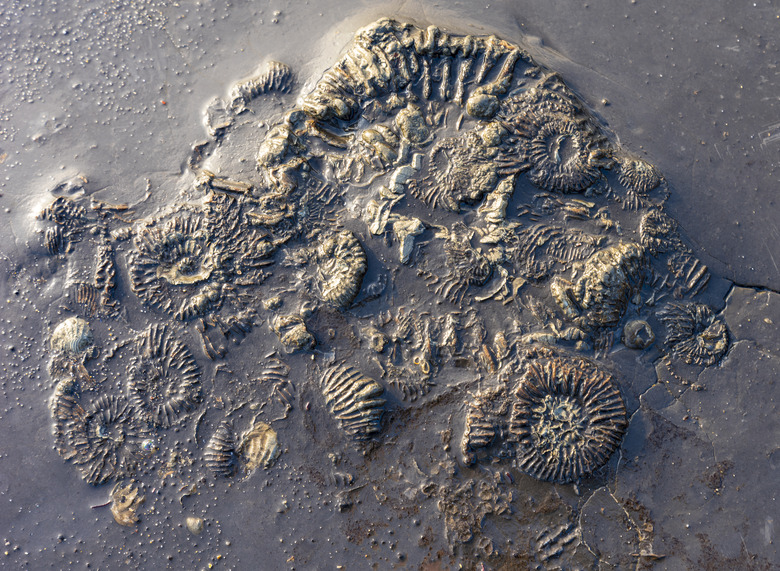Describe The Types Of Fossils
Along with genetics, fossils are one of the most useful windows we have into the natural history of life on Earth. Essentially, a fossil is a record of an organism, showing the size, shape and texture of different body parts. Common examples of fossils include teeth, skin, nests, dung and tracks. However, not all fossils are formed in the same way. There are two main types of fossils – body fossils and trace fossils – they provide different types of information about the organism depending on the organic matter that was fossilized and preserved for later observation.
Body Fossils
Body Fossils
Body fossils preserve the actual structure of an organism, whether this be bones, teeth, leaves, or some other aspect of the organism's actual primary structure. Fossils typically preserve the 'hard parts' of an organism, as the soft tissue will decompose too quickly for molds or mineralization to record it. There are three different types of fossils that record the body structure: molds, casts, and true form fossils.
Molds
A mold fossil is a fossilized imprint made in the substrate. The substrate is the rock or sediment on which a fossil makes its mark. Unlike cast fossils, mold fossils are hollow. Due to the way this type of fossil is formed, the resulting image is a negative image of the part of the organism's body that made the impression. In other words, it is backwards. Common mold fossils include skin, leaves, teeth, claws, and embryos.
Casts
Cast fossils are like mold fossils in that they formed, at least in part, with an imprint made in a rock or sediment. However, once the hollow molds are present, they are subsequently filled in with minerals that later harden to form solid rock through the process of permineralization. In other words, mold fossils take up negative space and cast fossils take up positive space. This casting process can use a variety of minerals including silica (often already found in plants) and pyrite (which results in shiny, metallic fossils).
Petrified wood is formed under a similar process, as minerals come to replace the organic material of the tree, and the petrification process preserves the original structure of the wood.
Preservation and True Form Fossils
Complete fossil preservation can occur when an organism is trapped within amber or sap. This is sometimes also called a true form fossil because the preserved remains are much more intact and complete. It can provide paleontologists the most accurate examination of organic material.
Traces
Traces
Trace fossils, also called ichnofossils, do not contain information about the organism itself. Rather, they contain information on traces left by the organism. Common examples of trace fossils include burrows, nests, footprints, dung, and tooth marks. These are the most common type of fossil, and can sometimes offer more information on how the organism lived (e.g. how it hunted and how it rested) than fossilized body parts can. The fossilized feces of ancient organisms are called coprolites.
How Fossils Are Formed
How Fossils Are Formed
Fossils are most often formed within sedimentary rock, where a living organism is covered with layers of sediment and minerals, locking their structure and skeleton in place. There are other ways fossils form, in tar pits and amber, but this method of mineral protection is very common. Most of the organism will decompose, leaving only exoskeletons, bones, and other hard organic matter.
Tip
Calcite (calcium carbonate) often preserves many fossils; when there is an abundance of fossil remains, it is then designated as fossiliferous limestone.
Fossils preserve a moment in geologic time that we can still see today. Many of the most common fossils are smaller organisms like trilobites, ammonites, snails, and clams; while they may not be as terrifying and large as dinosaur fossils, these abundant organisms make up much of the fossil record – which actually describes the earth's geologic history. Fossils that can be used to describe this progression of life and ecology are called index fossils, and they are incredibly important to paleontologists and geologists.
Cite This Article
MLA
Evans, Mike. "Describe The Types Of Fossils" sciencing.com, https://www.sciencing.com/describe-types-fossils-8147260/. 24 May 2023.
APA
Evans, Mike. (2023, May 24). Describe The Types Of Fossils. sciencing.com. Retrieved from https://www.sciencing.com/describe-types-fossils-8147260/
Chicago
Evans, Mike. Describe The Types Of Fossils last modified May 24, 2023. https://www.sciencing.com/describe-types-fossils-8147260/
